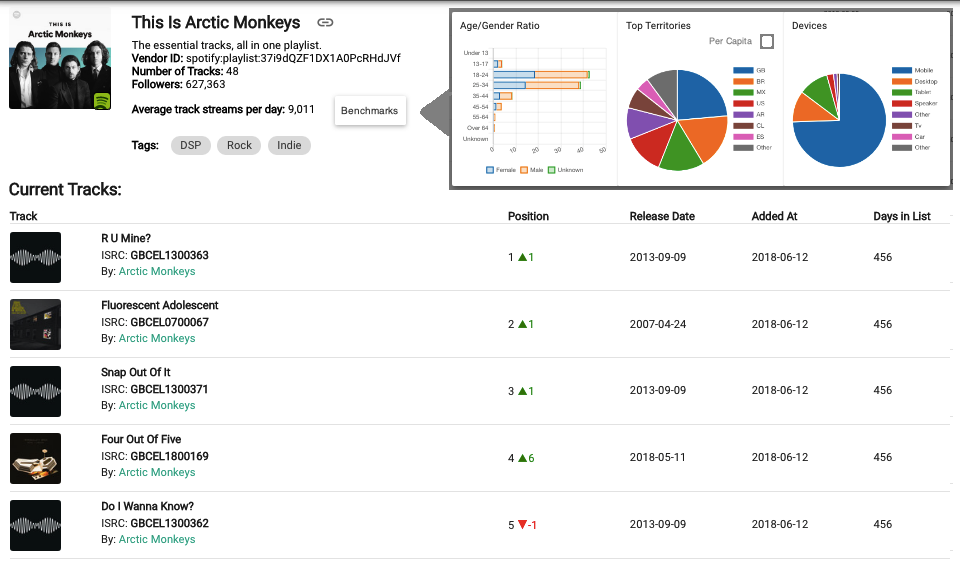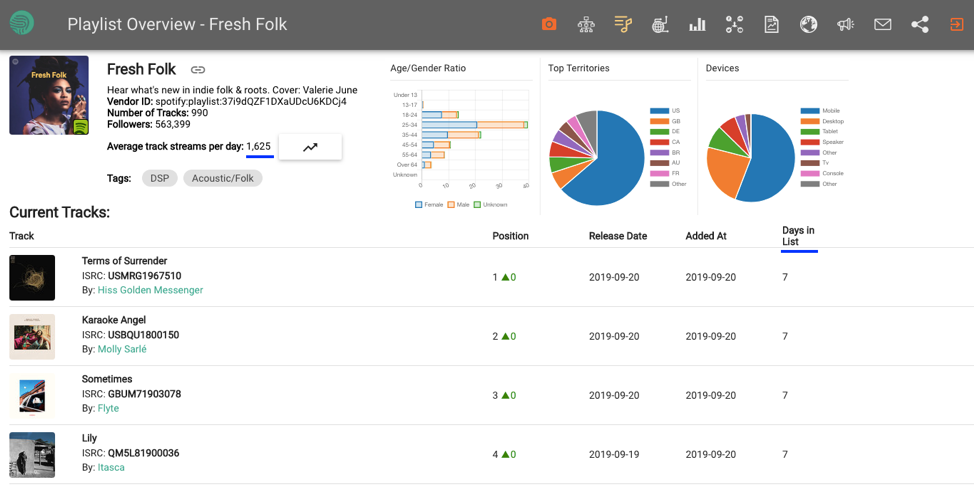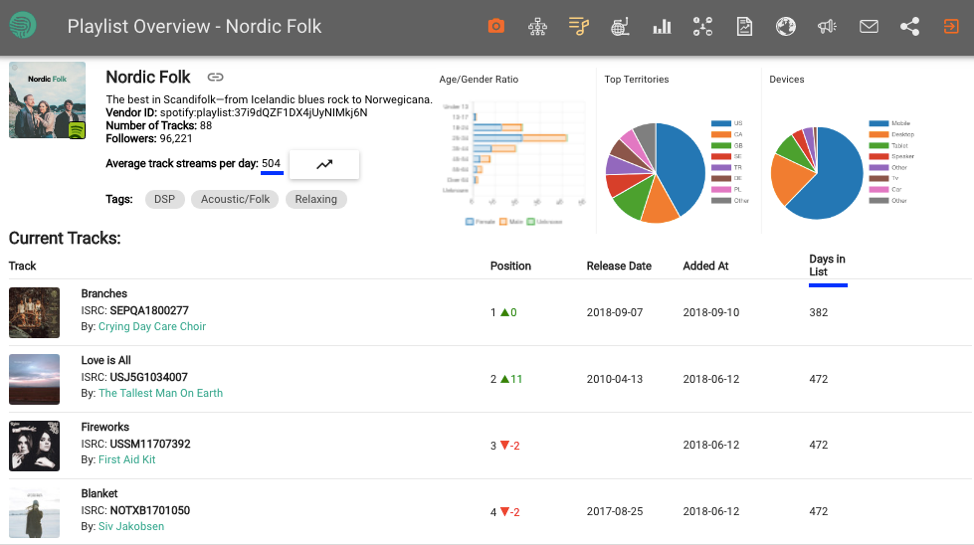Artists who are self-managed, or working with smaller teams or labels, often hear about the data we provide to labels and distributors and ask some variation on the question, “Why do I have to worry about this?” on top of all the other concerns of a working musician. It doesn’t take long to show why data can help them make good decisions, but then they face the next obstacle: where to get access to the data, when so few services provide it in helpful forms, and how to make sense of it.
These obstacles can be overcome, with just a little care and planning. But before we get to our advice on how to use data as an independent artist, it’s worth breaking down what we mean by “data,” where it comes from, and how artists need to understand it to thrive in this digital age.

Data Is Everything
Don’t worry, we’re not saying data’s all that matters, that it’s omnipotent. What we mean that every online device, transaction, communication, interaction, even emotion, is recorded somewhere, in some form.
Your mobile phone, smart speaker, TV, smart fridge, online food company, train operator, parking lot CCTV, coffee shop, office building, laptop, and email provider all record billions of lines of data about where you are and what you are doing. So before you’ve had time to ask who had a good weekend, there is a data trail of when you got up, what meal you’re planning for tonight, how you feel about the local election candidate, how often you miss your train, how much caffeine you need to feel human, the amount of litter you drop or bin, your favorite parking spot, and the private correspondence you finished off at your desk.
Retailers, influencers, broadcasters, sports teams, churches, even politicians we are discovering, are using whatever data they can get their hands on to attract, guide, encourage, or confuse you into listening to their message, and the same is very much true of the music industry.
No matter how we feel about the way data is being generated, collected, and used, it is happening and is not going to stop any time soon. So, artists, managers, promoters, agents, labels, distributors, and curators all need to learn how to embrace and benefit from the rich vein of music information that is out there.
Data Is Different
Not all data is equal and not all data is important, so knowing the difference is vital to an effective career in music.
The first thing to get straight is that Metadata and Consumption Data are very different things. The first is catalog information relating to a release of music, the label, artist(s), composers, genres, identifiers, street date, copyright details, royalty splits and digital assets (tracks, packshots etc.) that ensure the “work” is properly listed, sold, and paid for.
Consumption data includes all forms of sales, streams, downloads, video views, radio spins and live or public performances of the work. This can range from a few record shop sales of a deluxe vinyl album to 10 million YouTube views of your latest single, from an in-store performance to 100 superfans or 10,000 streams on a Hot Hits playlist.
Just to be clear, when someone says they are working with “millions of lines of music data,” it’s probably just metadata. If it’s billions, then it’s consumption data, from which you can determine the size of your audience, their demographics, location, preferred devices, favourite playlists and daily listening habits.
Data Has Value
Anyone who says they can guarantee to pick the next hit, just from data alone, is selling you snake oil, and anyone who says they don’t need data to inform their gut feel about a band is a fool (one winning pick lets them gloss over all the ones they made that failed). But the two forces together, that combination of guts, determination, patience, endless practice, and meaningful information, can allow you to make excellent decisions and potentially thrive in the music industry.
Let’s look at a simple example of how data can change the way we approach a decision, in this case what playlist to pitch hardest on Spotify. In the following example, we can see two folk playlists with a slightly different average track streams per day (ATSPD) benchmark. This is calculated from the average number of streams each track generates per day while on a playlist.
Fresh Folk (see figure 1) generates a decent number of streams per day. However, tracks are cycled through very quickly, so on average a track can only expect to be on here for 7 to 14 days (its lifespan). If we multiply the ATSPD 1,625 by the maximum track lifespan of 14 days, you can expect to get about 22,750 streams from your time on this playlist.

If we compare this to another popular playlist in this genre, Nordic Folk (see figure 2), we can see the ATSPD of 504 is less than a third of Fresh Folk. This number makes this playlist seem less promising. But here’s where it gets interesting: The retention of tracks is a lot higher, at about 380 days.
So, if we do the same calculation, it’s easy to see the return on this playlist is over 190k streams, which makes it worth fighting to get on to.
Both flavors of data can unlock similar insights that help you focus on what matters most, in a sea of possibilities. Here are just some of the ways you can improve your metadata and do more with your consumption data.

Good Housekeeping
- Keep your own metadata database (just a spreadsheet will do) with song titles, alternate titles, writers, ISRCs, ISWCs, UPC’s etc. so if there are ever disputes you will hold an authoritative set.
- Understand what all the data points mean and how they are used – read music blogs, listen to podcasts, visit trade shows and speak to others in the business about data.
- Make sure data is consistent across all platforms. Find your content on every service, check it, and keep all the links in your spreadsheet.
- Make sure data is consistent and accurate when sending to PRO’s, SoundExchange, etc.
- Work with labels or distributors that can provide deep granular analytics, not just top-line numbers. You’re looking for people that use listener-level data, not internet scraping tools.
Understanding Data
- Find a few similar artists, preferably performers who are where you’d realistically like to be in two years.
- What are they doing that you are not?
- Where are they getting traction with fans?
- Know where your fans are, and just as importantly, where you need to develop new fans.
- Are there nearby regions or cities that would let you build a tour, if only you had more fans there?
- Are there similar cities or markets that might respond well to your music?
- Know the true “worth” of a playlist addition, and what lists are worth your valuable pitching time. A few things to keep in mind:
- Millions of followers do not necessarily equate to millions of streams.
- Not all playlists are equal, so target ones that generate decent daily streams and will keep you on for longer (low churn rate).
- It’s better to find an engaged, long-term audience on a smaller playlist versus racking up some streams as a flash in the pan on bigger lists.
- Track how you are performing on each DSP.
- Is one doing better or worse and in what territories?
- Can you learn from how and where people are listening?
Take Action
- Feedback insights you glean and ask questions of your label, distributor, or booking agent. Use your data to back up your questions.
- Highlight areas of success and areas for improvement, and set meaningful, incremental goals for yourself with measurable results.
- Watch out for “spikes” in social media, video, and streaming data and ride the wave by pushing your valuable insights in front of tastemakers, playlist curators, and radio pluggers. Data can be persuasive, so make your case if you see things heating up.
Keep Being Creative
All this talk of metadata, audience demographics, playlist churn rates, and the like may make your head spin. In truth, some music analytics reports feel like you need a PhD in data science to understand them. It shouldn’t have to. You should focus on your music, not mastering statistics.
Here’s where you should press your team, be it an indie distribution platform or manager or small label, to help you get data clarity. At Ei, we to serve up the information artists to make informed decisions and push ourselves to find the right level of granularity. We listen to our clients and work hard to present what we know in an understandable and usable way. You need to make sure your pick a team that does the same, so you can focus on being the amazing creative force you are and spreading your art to those who appreciate it. Data should help, not hinder you, in this, letting you respond to your fans and predict your potential audiences in an informed way.
About the Author

Greg Delaney is the founder of Entertainment Intelligence.
Learn more at https://entertainment-intelligence.com
